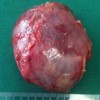Castleman’s Disease Mimetizing Pancreatic Tumor
Abstract
Context Angiofollicular lymph node hyperplasia or Castleman’s disease is a rare clinical condition. Knowledge about etiology and physiopathology; and treatment management as well are yet to be defined. Unicentric presentation of this disease affecting single lymph nodes in the mediastinum seems to be the most common presentation. Castleman’s disease localized in the pancreas topographic area that mimics a pancreatic neoplasm is an even more uncommon event, with available published data of less than 15 cases until now. Case report We present a 64-year-old male patient with a six-month past history of asthenia, adynamia, and lack of general clinical conditions. Imaging studies showed a nodular hypoechoic mass in the pancreatic head. Enucleation of the lesion was performed. Histopathological study revealed unicentric form of Castleman’s Disease. Conclusions Castleman’s disease mimetizing pancreatic tumor is uncommon and it also curses with a difficult preoperative diagnosis. Surgery seems to be the best therapeutic alternative for this disease.
Downloads
References
Castleman B, Iverson L, Menendez VP. Localized mediastinal lymph-node hyperplasia resembling thymoma. Cancer 1956; 9:822-30.
Keller A R, Hochholzer L, Castleman B. Hyaline-vascular and plasma-cell types of giant lymph node hyperplasia of the mediastinum and other locations. Cancer 1972; 29: 670-83.
McCarty MJ, Vukelja SJ, Banks PM, Weisst RB. Angiofollicular lymph node hyperplasia (Castleman's disease). Cancer Treat Rev 1995;21:291-310.
Wang H, Wieczorek RL, Zenilman ME, Desoto-Lapaix F, Ghosh BC, Bowne WB. Castleman's disease in the head of the pancreas: report of a rare clinical entity and current perspective on diagnosis, treatment, and outcome. World J Surg Oncol. 2007; 20;5:133.
Flendrig J A. Benign giant lymphoma. Volia Med. Need. 1969; 12: 119-20.
Gaba AR, Stein RS, Sweet DL, Variakojis D. Multicentric giant lymph hyperplasia. Am J Clin Pathol. 1978; 69: 86-90.
Kojima M, Nakamura S, Miyawaki S, Ohno Y, Sakela N, Majawa N. Progressive transformation of germinal center presenting with histologic features of hyaline-vascular type of Castleman's disease. APMIS. 2005; 113:288-95.
Frizzera G. Castleman's disease: more questions than answers. Hum Pathol 1985; 156:202-5.
Dispenzieri A, Gertz MA. Treatment of Castleman's disease. Curr Treat Options Oncol. 2005;6(3):255-66.
Bowne WB, Lewis JJ, Filippa DA, Niesvizky R, Brooks AD, Burt ME, et al. The management of unicentric and multicentric Castleman disease: a report of 16 cases and a review of the literature. Cancer 1999; 85:706-17.
Erkan N, Y?ld?r?m M, Selek E, Sayhan S. Peripancreatic Castleman disease. JOP. J Pancreas (Online) 2004; 5(6):491-4.
Le Borgne J, Joubert M, Emam N, Gaillard F, Lafergue JP, Moussu P, Lehur PA. Pancreatic localization of a Castleman's tumor. Gastroenterol Clin Biol 1999; 23:536-8.
De Albuquerque AC, Silva Junior OE, Ferraz AAB. Castleman disease presenting as pancreatic tumor. Rev Col Bras Cir 2003; 30(5): 396-8.

Copyright (c) 2014 Franz Robert Apodaca-Torrez, Benedito Herani Filho, Reinaldo Isaacs Beron, Alberto Goldenberg, Suzan Menasce Goldman, Edson José Lobo

This work is licensed under a Creative Commons Attribution 4.0 International License.
As a member of Publisher International Linking Association, PILA, iMedPub Group’s JOP follows the Creative Commons Attribution License and Scholars Open Access publishing policies. Journal of the Pancreas is the Council Contributor Member of Council of Science Editors (CSE) and following the CSE slogan Education, Ethics, and Evidence for Editors.